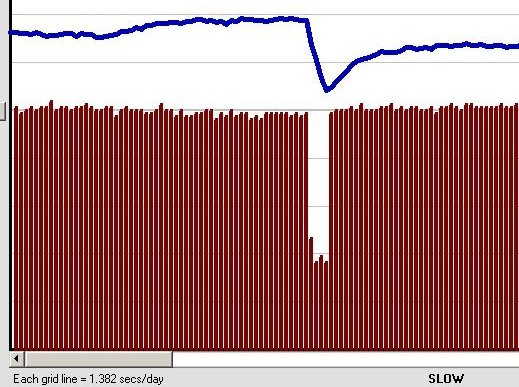This will only apply to a good quality precision timepiece or clock, that is in a reasonably (though not completely) airtight case.
In this Microset graph I opened the door for approximately 16 minutes before closing it again. This can be seen by the drop in the middle of the graph (each vertical brown bar is a reading of the pendulum's rate taken every four minutes) The upper blue line represents the speed of the pendulum, which is also being monitored. The dip here indicating an increase in amplitude while the door is open.
The reason for this drop in rate is that with the door closed the pendulum has to displace the air in the case with each swing. Whilst the case is not airtight, it can be considered as a closed space in which the air is pushed around.
This presents a small resistance to the pendulum each time it swings. As long as this resistance stays the same it can of course be allowed for and will normally present no problem.
With the door open however this resistance decreases, allowing the pendulum to swing easier as it now only needs to displace the air contained in the atmosphere, rather than that within a small closed space.
The natural assumption would be that the clock would therefore gain, but in fact it looses. The reason for this is a phenomenon called 'circular error'.
When Galileo first got the concept of a pendulum's period by using his pulse to time a swinging lamp in a Pisa cathedral, he and others assumed that the period of swing depended solely on the length of the pendulum rod, and not on the arc it swings through. This is almost true, but it was soon discovered by a Dutchman called Christiaan Huygens that as the arc increases a slight increase in the rate occurs as well.
Each horizontal line of the graph represent a difference of 1.382 seconds a day, so my timepiece would loose 4.146 seconds a day if the door was left open for the whole day.
If this was the case {no pun intended} you would simply adjust the clock to run quicker, but if you open it one day, and close it the next, you would wonder why the clock varied so much from day to day!
Another source of confusion could occur if the door is warped and its seal (or air tightness) varies with the weather, or is dependant on you remembering to push it tight.
In both instances seemingly unexplainable errors will occur.
Original Synchronome Literature and Instructions
 |
||
 
Synchronome Master Clock
The effect on the timekeeping of opening and closing the door. |
 Custom Search
My Other Websites:   Synchronome Introduction
Operation Setting Up Impulse Movement Rating Date Chart Barometer Pressure Door Open Effect Circular Error Door Open Effect Power Station Model Synchronome Literature Gents Pul-syn-etic Gensign Post Office 36 Carl Bohmeier Bürk Master Clock General Tele's Ltd Slave Dials Programmer Links and Contact Page |
|
 Site Last Updated 27th August 2018 Legal Nonsense © Copyright |
||